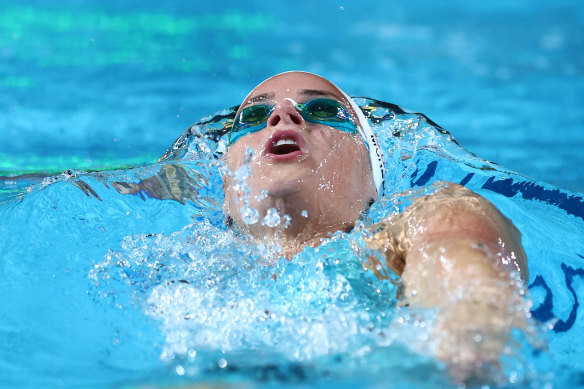- Science of sport
- Sport
- Swimming
- Paris 2024
Why staying underwater (and using a dolphin kick) might be the key to gold
If the Dolphins want to match their haul of nine gold, three silver and eight bronze medals at Tokyo 2020, they will not only have to beat the best swimmers in the world, they will also be battling another formidable foe – the water’s drag.
Generating immense power is essential to swimming fast, but overcoming the resistance of drag is equally crucial for victory. So, why is it a problem, and what should you look for in the race for gold?

This photo of Kaylee McKeown at the Australian Swimming trials last month shows us where drag is visible in a race. The pressure of McKeown’s head pushing into the water forces the water up into a wave in front of her, which takes energy from her and slows her down. This is something that affects all swimmers.Credit: Getty Images
Water is a drag because it’s so dense. And this drag slows swimmers down, especially in the fastest parts of the race, such as the starts and turns. That means reducing drag is key to swimming success.
But, contrary to intuition, keeping the body out of the water by sitting high on the water’s surface is not the fastest way to swim.
Swimming on top of the water generates waves as the head and body pushes the water in front and into the air. Creating waves takes energy, and this energy comes from the swimmers themselves, costing them time and energy.
Their solution? To stay underwater as long as possible, even though they can’t use those powerful arm strokes while they’re there.
Swimmers have long recognised the advantages of subaquatic propulsion. Controversy reigned in the breaststroke event back in the 1956 Melbourne Olympic Games when swimmers stayed underwater for most of their races.
The men’s 200m winner, Masaru Furukawa of Japan, swam most of the first three of the four laps underwater. In response, the practice was quickly outlawed.
In recent years, the use of techniques such as the dolphin kick has revolutionised the sport, enabling swimmers in other events to use the laws of physics to their advantage.
By undulating their bodies in a wave-like motion underwater while maintaining a streamlined posture, athletes propel themselves forward with remarkable efficiency.
At least, they can do this within the laws of swimming – because the technique is so effective, swimmers must now breach the surface before passing the 15m mark of each lap, as indicated by the row of flags draped across the pool.
Perfecting this underwater technique is now a cornerstone of training regimens. Swimmers spend countless hours perfecting their underwater techniques on starts and turns, where it’s legal to stay underwater.
So, when you’re sitting on the edge of your seat cheering on Australia’s super fish as they compete against the best in the world, pay close attention to the underwater action to see which swimmers stay underwater the longest during starts and turns.
And if you have a keen eye, you might even look for those with faster kick speeds, those who keep farthest below the water’s surface, and those whose feet undulate the most about their ankles, mimicking the propulsion mechanisms of superfast mammals like dolphins and whales.
They might just eke out an advantage that turns a small deficit into a stunning win.
For Olympics news, results and expert analysis sent daily throughout the Games, sign up for our Sport newsletter.